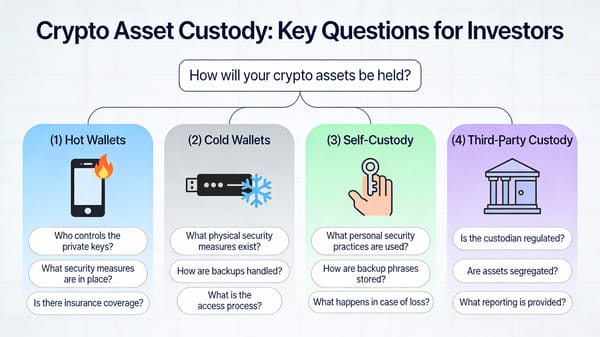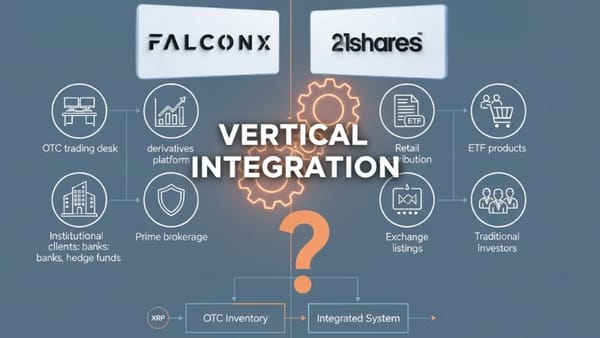Is the Crypto Flash Crash a Tsunami Pullback: Are Whales Riding the Incoming XRP ETF Wave While Retail Watches the Crash?
XRP ETFs launch amid market turbulence as whale shorting, Argentina crisis, and Japan bond shock create volatility. Is this a strategic dip before the October approval wave? Institutional flows suggest smart money is positioning.

BOTTOM LINE UP FRONT: Like the ominous calm when ocean waters recede before a tsunami strikes, October 10's crypto market crash may represent the pullback before a massive wave. While retail investors fixate on exposed seabed—today's volatility driven by whale shorts, Argentina's crisis, and Japan's bond shock—multiple XRP ETFs quietly launched and six major spot approvals loom for October 18-24. The question: Are institutional whales already positioned in the incoming wave while retail stands confused on the beach?
The Incoming Wave: XRP ETFs Building on the Horizon
While most eyes remained fixed on the receding tide, a massive wave was building on the horizon. The crypto landscape witnessed a watershed moment this week as multiple XRP exchange-traded funds successfully launched, including the Teucrium 2x Long Daily XRP ETF (XXRP), which went live in October despite the ongoing U.S. government shutdown.
This wasn't random timing. Like the first tremors before a tsunami, these launches signal something larger approaching. Several XRP futures-based ETFs have already begun trading in 2025, with Volatility Shares' XRP ETF (XRPI) launching May 22, 2025, as the first non-leveraged XRP futures ETF in the United States. ProShares Ultra XRP ETF (UXRP) followed in mid-July.
But the most significant wave marker came when the REX-Osprey XRP ETF (XRPR) launched September 18, 2025, as the first U.S.-listed fund offering direct spot exposure to XRP. The product's debut revealed the power building beneath the surface: it attracted $37.7 million in first-day volume—the highest for any ETF launch in 2025. The wave was forming.
October 18-24: When the Wave Reaches Shore
The crypto industry faces a pivotal moment as the wave approaches landfall. Six spot XRP ETF applications from major asset managers including Grayscale, 21Shares, Bitwise, Canary, CoinShares, and WisdomTree are reaching final SEC deadlines between October 18-24. Bloomberg analysts assign these applications a 95% approval probability, while online prediction markets price approval chances at 99%.
The wave's timing, however, faces an obstacle. The ongoing U.S. government shutdown that began October 1 has temporarily paused the SEC's review process, leaving approximately 90 ETF filings in limbo. Eric Balchunas, Bloomberg's ETF expert, acknowledged the delay: "From what I hear, everything is on ice… It's like a rain delay. Bad time, but what are you gonna do."
Yet tsunamis don't stop for bureaucracy. Despite the shutdown, the wave continues building. The SEC's September 17, 2025 approval of generic listing standards for commodity-based trust shares streamlined the approval process, potentially enabling rapid simultaneous approvals once government operations resume. Crypto commentator Kenny Nguyen noted that all eleven XRP ETF filings have already crossed their 75-day review windows under the new framework and are technically ready for approval.
When the wave breaks, it could be massive. Market analysts project that if multiple spot XRP ETFs receive approval simultaneously, first-year inflows could reach $5-7 billion—institutional capital that would dwarf today's market pullback.
The Exposed Seabed: Understanding Today's Market Pullback
October 10, 2025, brought significant turbulence to crypto markets—the kind of dramatic retreat that reveals what lies beneath. Bitcoin briefly dipped below $120,000 and altcoins including XRP experienced 15-30% declines. Like beachgoers staring at an exposed ocean floor, retail investors watched scattered crypto assets lying vulnerable on the dry seabed of market panic.
The selloff coincided with escalating U.S.-China trade tensions, as President Trump announced a 100% additional tariff on China, triggering sharp declines across risk assets. But was this the main event, or merely the water pulling back before something bigger?
Whales Swimming in the Wave: Strategic Positioning During the Pullback
The downturn was amplified by what appeared to be strategic whale positioning. An "OG" Bitcoin whale placed a leveraged short of 3,600 BTC valued at $438 million on the decentralized exchange Hyperliquid during overnight trading. This same entity had previously sold 35,991 BTC to diversify into Ethereum, demonstrating sophisticated portfolio rebalancing. Whether this represents tactical positioning ahead of anticipated moves or simply risk management remains open to interpretation.
But here's where the tsunami metaphor becomes critical: While this whale appeared to short the pullback, other whales were doing something entirely different.
Nearly 200,000 traders were liquidated in the 24-hour period, with total liquidations jumping 113% to over $690 million. Bitcoin and Ethereum longs suffered the most pain, suggesting overleveraged retail positions were flushed from the system. Yet amid this chaos, a different story was unfolding beneath the surface.
Despite the volatility—or perhaps because of it—Bitcoin ETFs demonstrated resilient institutional demand, drawing $2.72 billion in weekly inflows. BlackRock's iShares Bitcoin Trust (IBIT) led with $255 million in daily inflows, while total Bitcoin ETF assets climbed to $164.79 billion, representing nearly 7% of Bitcoin's market capitalization.
This is the paradox of the tsunami pullback: Retail investors see the exposed seabed and panic. Institutional whales see the receding water and know what's coming next. The accumulation during market weakness could suggest sophisticated players are already swimming in position, riding the incoming wave—or it may simply reflect long-term institutional allocation strategies independent of short-term price action.
Global Tremors: Argentina and Japan Create the Conditions for Pullback
The crypto selloff didn't occur in isolation. Like seismic activity that triggers tsunamis, two major macro developments sent shockwaves through global financial markets on October 9-10, creating the broader risk-off sentiment that pulled crypto waters back from shore.
Argentina's Currency Crisis Deepens
Argentina's peso crisis intensified as President Javier Milei's government burned through billions of dollars defending the currency ahead of critical October 26 legislative elections. Traders estimate Argentina's Treasury has as little as $700 million left in dollar reserves, forcing extraordinary intervention from the Trump administration.
Treasury Secretary Scott Bessent announced that the United States directly purchased Argentine pesos and finalized a $20 billion currency swap framework with Argentina's central bank. This rare move aimed to stabilize the peso, which had fallen more than 6% in a single day in early October—its biggest drop since September 8.
The crisis sparked controversy, as U.S. farmers and Democratic lawmakers criticized the intervention as a "bailout" that benefited Argentina's agricultural sector at the expense of American producers. Argentina had suspended export taxes on soybeans after the U.S. lifeline was announced, prompting China to purchase Argentine soybeans instead of U.S. crops.
The Argentine situation highlighted the fragility of emerging market currencies and increased demand for decentralized, censorship-resistant assets like Bitcoin and XRP as hedges against sovereign currency risk.
Japan Bond Market Volatility Spreads Globally
Simultaneously, Japan's typically stable $8 trillion government bond market experienced significant turbulence following Sanae Takaichi's surprise victory in the ruling Liberal Democratic Party leadership race. Takaichi, poised to become Japan's first female prime minister, advocates pro-stimulus policies that raised concerns about increased government borrowing.
Japan's 30-year bond yield jumped over 13 basis points to 3.291% following the election, hovering near all-time highs. Goldman Sachs warned that for every 10 basis point "idiosyncratic JGB shock," investors can expect around 2-3 basis points of upward pressure on U.S., German, and UK yields.
The Japanese bond selloff created ripple effects across global fixed income markets, pushing long-dated yields higher worldwide and reducing appetite for risk assets including cryptocurrencies. Bloomberg characterized this volatility as marking the end of an era where Japan's rock-bottom rates acted as an anchor for bond yields globally.
The Dry Seabed: Exchange Liquidity Reveals What Lies Beneath
While today's trading volume surged to $206 billion across crypto markets, some observers noted unusual liquidity dynamics that revealed the true nature of the pullback. The quote from Economic Ninja highlighted a critical phenomenon: during sharp selloffs, buyers struggled to fill large orders despite substantial downward pressure.
This phenomenon suggests thin order books at key price levels, where relatively small selling volume can create outsized price impacts—like a receding tide exposing the rocky ocean floor. The observation that "people with large money couldn't even get an order through because there's very little selling happening" reveals a crucial insight: participants are holding positions rather than panicking.
This dynamic could be consistent with the tsunami model. When the water pulls back before a wave, it's not because everyone is selling—it's because forces beneath the surface are drawing water into the incoming wave. Strategic accumulation by sophisticated investors who recognize that temporary price dips ahead of major catalysts (like XRP ETF approvals) represent buying opportunities would create exactly this pattern. The inability to easily deploy large capital during dips might suggest limited panic selling and more conviction among holders—though it could also simply reflect thin weekend liquidity and reduced market maker activity during holiday periods.
The key question: Is the exposed seabed evidence of panic, or preparation? Are holders refusing to sell because they see the wave building on the horizon?
Are Whales Already Riding the Wave? The Case for Strategic Positioning
The confluence of factors—XRP ETFs already trading successfully, imminent spot ETF approvals, whale activity during the pullback, and macro pressures creating temporary selloffs—paints a picture familiar to anyone who has studied tsunamis. The water recedes dramatically, revealing the ocean floor. Inexperienced beachgoers rush out to explore the exposed seabed. Then the wave hits.
The question that matters: Are institutional whales already positioned in the incoming wave while retail investors stand confused on the beach?
Several data points support this possibility, though alternative explanations exist:
Institutional ETF Flows: Despite market volatility, Bitcoin ETFs posted $1.21 billion in net inflows on October 6, the largest daily intake of 2025 and the biggest since July 10. This preceded Bitcoin achieving new all-time highs above $126,000. The pattern could suggest institutions accumulate during weakness and position ahead of positive catalysts—or it may simply reflect regular portfolio rebalancing and dollar-cost averaging strategies.
Muted Retail Panic: The Economic Ninja observation that large buyers couldn't fill orders despite price declines could indicate retail holders aren't panic-selling. This might suggest conviction among existing holders who recognize the ETF approval timeline—or it could simply reflect thin holiday weekend liquidity with reduced market participation.
Historical Q4 XRP Performance: XRP has delivered positive returns in Q4 since 2013, averaging over 150% gains during bull market cycles. The standout year was 2017, when XRP surged 1,060% in Q4 alone. Most recently, XRP rallied 240% in Q4 2024, making October-December historically favorable for the asset. However, past performance doesn't guarantee future results, and each market cycle operates under different conditions. Whether historical seasonality will repeat in 2025 remains uncertain.
ETF-Driven Precedent: The January 2024 Bitcoin spot ETF launch triggered a massive rally that attracted billions in institutional capital. XRP bulls anticipate similar dynamics, though several key differences exist. XRP has a smaller market capitalization and more concentrated holder base, which could amplify volatility in either direction. Whether the Bitcoin ETF playbook translates directly to XRP remains uncertain.
Analyst Price Targets: Multiple analysts have issued bullish projections contingent on ETF approvals. XRP analyst XForceGlobal suggested the asset could reach $20-$30 in October, while Egrag Crypto set targets between $15 and $27. While these projections may appear optimistic and should be viewed with appropriate skepticism, they do reflect growing conviction among some market participants that ETF approvals could drive substantial price appreciation. Historical precedent shows analyst targets during bullish catalysts often prove either overly optimistic or conservative, making such predictions uncertain guides for actual outcomes.
XRP-Specific Impact Analysis
The impending wave of spot XRP ETF approvals carries profound implications for Ripple, XRP's price trajectory, and the broader digital asset ecosystem.
Price Potential
XRP currently trades around $2.75, well below its all-time high above $4. The resolution of Ripple's SEC lawsuit in summer 2025 removed a major regulatory overhang that had suppressed price action for years. With that obstacle cleared, ETF approvals could represent the next major catalyst.
If spot XRP ETFs attract even a fraction of the capital that flowed into Bitcoin ETFs, the impact might be substantial. Analysts project $5-7 billion in first-year flows if multiple products launch simultaneously. Given XRP's current market capitalization of approximately $150 billion, institutional inflows of this magnitude could potentially drive significant price appreciation—though the actual outcome would depend on numerous factors including market sentiment, broader crypto conditions, and how institutional capital actually deploys across available products.
Ripple Business Operations
For Ripple Labs, ETF approvals could validate XRP as a legitimate financial asset suitable for institutional portfolios. This recognition might accelerate Ripple's core business of cross-border payments and remittances, as banks and financial institutions potentially gain confidence in XRP's regulatory standing.
The company's On-Demand Liquidity (ODL) product, which uses XRP to facilitate instant cross-border payments, might see expanded adoption as institutional comfort with the asset increases. Major financial institutions that previously hesitated due to regulatory uncertainty could potentially consider integrating XRP-based solutions—though this remains speculative and would depend on individual institutional risk assessments and compliance frameworks.
Legal Standing
The SEC's approval of XRP ETFs would provide significant practical regulatory clarity, though it may not definitively resolve all legal questions. This represents a dramatic shift from the SEC's 2020 lawsuit alleging XRP was an unregistered security.
While the lawsuit settlement didn't definitively classify XRP's status, ETF approvals would provide important practical guidance. If the SEC approves spot XRP ETFs, it would implicitly acknowledge XRP can be held and traded by regulated investment vehicles, substantially reducing—though perhaps not entirely eliminating—future legal risk. However, the SEC has historically maintained that approval of an ETF doesn't constitute endorsement of the underlying asset, leaving some regulatory ambiguity.
Partnership Opportunities
Institutional legitimacy through ETF approvals might unlock partnership opportunities that were previously untenable. Major banks, asset managers, and fintech companies that avoided XRP due to regulatory uncertainty may explore integrations, though institutional decision-making typically moves slowly and involves extensive due diligence.
Ripple has already established partnerships with over 300 financial institutions globally, but many large U.S.-based firms remained on the sidelines during the SEC litigation. ETF approvals could potentially catalyze a new wave of American institutional partnerships, expanding Ripple's network effects and utility—though the actual pace and scale of such partnerships would depend on numerous factors beyond regulatory clarity alone.
Adoption Prospects
Perhaps most significantly, ETF approvals could democratize XRP access for millions of retail investors who prefer regulated investment vehicles over direct token purchases. Many investors—particularly those with retirement accounts or institutional mandates—cannot directly purchase cryptocurrencies but can invest through ETFs.
The ability to gain XRP exposure through tax-advantaged accounts like IRAs and 401(k)s might drive substantial new demand. Additionally, financial advisors who face regulatory restrictions on recommending direct crypto purchases may be able to include XRP ETFs in client portfolios, potentially expanding the investor base significantly. However, whether this theoretical access translates into actual capital flows remains to be seen and would depend heavily on advisor adoption rates and client interest.
Market Outlook: Watching the Horizon
The next few weeks will prove critical for XRP and the broader crypto market. Like watching a tsunami approach, several scenarios could unfold, each with varying degrees of probability:
Bullish Scenario - The Full Wave (Possible but Uncertain): The government shutdown ends before October 18, enabling the SEC to simultaneously approve multiple spot XRP ETFs. The wave breaks with full force, triggering substantial institutional inflows potentially reaching $5-7 billion in the first year. Combined with Q4 seasonality and continued Bitcoin ETF momentum, XRP might surge toward $10-15 by year-end as alt season floods the market. However, this scenario requires multiple favorable conditions to align simultaneously—the perfect storm, so to speak.
Base Scenario - The Rolling Wave (More Probable): The shutdown extends into late October but ends before the final deadline windows expire. The SEC approves 2-4 spot XRP ETFs in a staggered fashion, and the wave arrives in stages rather than all at once. Moderate inflows of $2-3 billion initially generate upward momentum, with XRP potentially appreciating to the $5-7 range as institutional adoption gradually increases. The tide comes in, but not as a single overwhelming surge.
Bearish Scenario - The False Alarm (Less Likely but Possible): The shutdown extends beyond critical deadlines, forcing the SEC to deny or postpone multiple applications. Only 1-2 spot XRP ETFs receive approval, generating limited institutional interest. The water continues to recede, and the anticipated wave never materializes. XRP might remain range-bound between $2-4 as the market awaits clearer regulatory direction. Alternatively, a broader market correction could override ETF optimism entirely, creating an extended low tide.
Given the substantial institutional preparation, regulatory framework changes, and successful launch of futures-based XRP ETFs, the bullish and base scenarios appear more probable than outright denials. However, cryptocurrency markets remain inherently volatile and subject to rapid sentiment shifts. The "tsunami wave" theory, while supported by circumstantial evidence, remains speculative rather than proven. The water has pulled back—but whether a wave follows depends on forces we can observe but not fully control.
Key Takeaways for Investors
- Multiple XRP ETFs are already trading successfully, including the landmark REX-Osprey spot ETF that launched with record volume, demonstrating institutional demand.
- Six major spot XRP ETF applications face October 18-24 deadlines with 95%+ approval probability according to Bloomberg analysts and prediction markets.
- The U.S. government shutdown is delaying approvals but hasn't derailed the fundamental regulatory progress enabling XRP ETFs.
- Today's market volatility stems from multiple factors: whale positioning, U.S.-China trade tensions, Argentina's currency crisis, and Japan bond market turbulence—not fundamental deterioration in crypto fundamentals.
- Institutional Bitcoin ETF inflows remain robust despite price volatility, suggesting sophisticated investors are accumulating during weakness.
- Historical patterns favor XRP in Q4, with the asset averaging 150%+ gains during bull market fourth quarters since 2013.
- Strategic positioning remains speculative, as large investors' reported difficulty deploying capital during selloffs could indicate conviction among holders or simply reflect thin weekend liquidity. The interpretation depends heavily on perspective and available evidence.
- Global macro instability in Argentina and Japan may be driving some capital into decentralized assets as hedges against sovereign currency and bond market risk—though this remains one interpretation among several possible market dynamics.
The confluence of imminent ETF approvals, apparent institutional positioning, and historical seasonal strength raises an intriguing possibility: the current pullback might represent a strategic entry point rather than a fundamental turning point. However, investors must carefully weigh these potentially bullish catalysts against genuine macro uncertainties and regulatory risks. The "strategic dip" theory, while compelling, remains unproven speculation rather than confirmed fact.
As Economic Ninja noted, weekend volatility with low volume often precedes significant Monday moves. With XRP ETF deadlines approaching, government shutdown dynamics evolving, and institutional capital clearly interested in crypto exposure, the next two weeks could prove decisive for digital assets broadly and XRP specifically.
The question isn't whether institutional crypto adoption will continue—that trajectory appears firmly established. Rather, the question is whether XRP can capitalize on this moment to join Bitcoin and Ethereum as a core institutional holding, or whether regulatory delays and market volatility will postpone its breakthrough. And the deeper question raised by today's market action: Was the volatility random chaos, or calculated positioning by sophisticated players ahead of a major catalyst? The evidence suggests possibilities in both directions, leaving investors to draw their own conclusions based on the available data.
DISCLAIMER: This newsletter is for informational purposes only and does not constitute investment advice, advertising, or a recommendation to buy, sell, or hold any securities. This content is not sponsored by or affiliated with any of the mentioned entities. Investments in cryptocurrencies or other financial assets carry significant risks, including the potential for total loss, extreme volatility, and regulatory uncertainty. Past performance is not indicative of future results. Always consult a qualified financial professional and conduct thorough research before making any investment decisions.
Sources
- TradingView: XRP ETF Filings and Deadlines
- CCN: XRP ETFs Tracker
- Yahoo Finance: XRP Price Prediction October
- DailyForex: XRP ETF Approval Impact
- Bitcoinist: XRP ETFs and Government Shutdown
- CoinDesk: Bitcoin Whale Short Position
- CryptoNews: Market Analysis October 10
- BanklessTimes: Crypto Market Crash Analysis
- CNN: US Purchases Argentine Pesos
- Bloomberg: Japan Bond Market Volatility
- CNBC: Takaichi Victory Impact on Japan Bonds
- Investing News Network: Crypto Market Recap
- CCN: Bitcoin ETF Inflows



